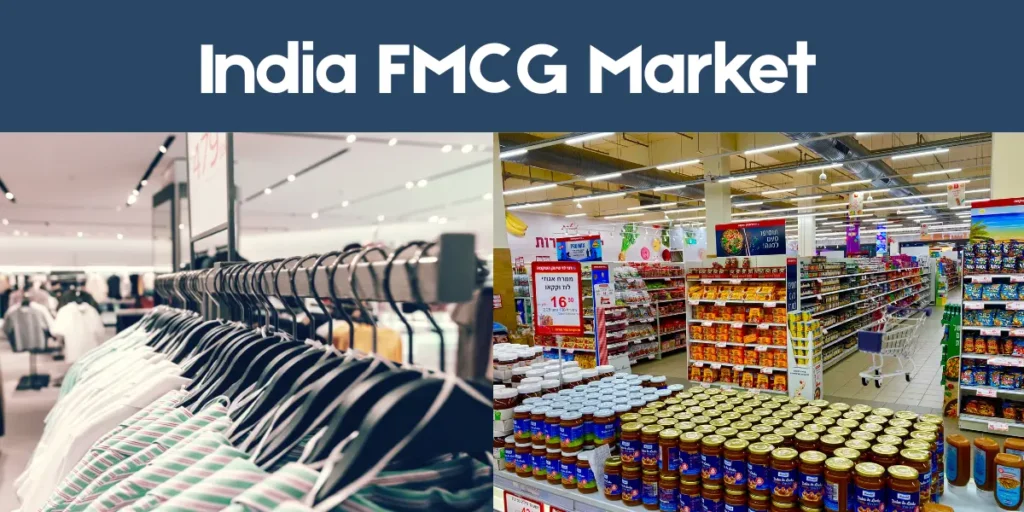Indian FMCG Market Overview
| Report Analysis | Key Statistics |
|---|---|
| Base Year | 2025 |
| Forecast Year | 2025-2033 |
| Historical Years | 2019-2024 |
| Market size in 2025 | USD 220 billion |
| Market forecast 2033 | USD 1,178 billion |
| Market growth rate (2025-2033) | 17.33% |
FMCG stands for fast-moving consumer goods, which are products that sell quickly because they are used frequently and have a high turnover rate in stores.
The Indian FMCG market growth is driven by the rapid increase in disposable incomes, urbanization, and semi-urbanization. As more people move towards a modern lifestyle, demand for convenience-driven products such as packaged food items, beverages, and personal care items is increasing.
The expansion of retail stores and e-commerce platforms is providing easy availability of FMCG brands and goods such as food and beverages, toiletries, oral hygiene, personal care, and detergents.
The rising disposable income of the population has influenced the FMCG industry in India positively. Higher purchasing power has changed the spending patterns and consumer behaviour. People with high disposable income move towards luxury purchases such as skin care, organic food, and branded personal care items.
Key Takeaways About the FMCG Market:
- According to the market estimates for 2025, the FMCG market size in India is expected to be between USD 211 billion and USD 220 billion.
- Projections reaching USD 1178 billion by 2033, reflecting a strong compound annual growth rate (CAGR) of around 21.8% from 2025 to 2033.
- For FY2025, revenue growth is expected to be 7-9%, with the sector expected to reach USD 132 billion in total revenue for the year.
- The sector’s substantial growth is due to an increase in disposable income, urbanization, rural penetration, and the growth of e-commerce.
The largest segment of the FMCG market is food and beverages, which is expected to maintain its lead by 2030. There is significant growth of rural areas as well, due to an increase in internet penetration, e-commerce access, and demand for smarter products.
Rural markets contribute a third of the overall FMCG market and are growing faster than urban markets by volume, 8.4% year-on-year in rural areas versus 2.6% in urban India as of early 2025.
Indian FMCG Market Trends
1. Rise in Demand for Health and Wellness Products
Awareness related to health and a health-conscious lifestyle are among the major reasons for the demand for FMCG. People are concerned about their health and wellness and are opting for organic goods, natural products for daily use, and low-sugar products.
The concern about nutrition, immunity, and health-related issues influences people to go for ayurvedic products and fortified food. With increased demand in this sector, companies are also innovating in these categories.
There is a notable shift towards health and wellness products, with the health food market projected to reach ₹1.5 trillion by 2025.
2. Digital Transformation and E-Commerce
E-commerce and digital marketing are transforming FMCG distribution and consumer engagement. Companies are leveraging platforms like Amazon and Flipkart, as well as social media, to reach new customers and drive sales.
Large-scale FMCG markets are adopting digital change to personalize offerings and achieve maximum customer satisfaction through data analytics and artificial intelligence. The D2C has also asked small brands to reach directly to consumers and cut through immediate platforms.
3. Rise in Disposable Income
The growing disposable income of the indian population has influenced the FMCG market a lot. They have changed their spending patterns, adopting goods that are eco-friendly, healthy, harmless to skin and body, and luxuries such as branded personal care items have increased the demand for products.
Packaged products like food, drinks, and beverages, and prepared meals benefit from this disposable income.
Indian FMCG Market Challenges
1. Rise in Raw Material Cost
Raw materials like edible oils, dairy, grains, and chemicals form the bulk of input costs in FMCG production. India imports 57% of edible oils, and these costs are highly sensitive to global commodity prices due to geopolitical tensions, currency fluctuations, and supply chain disruptions.
| Commodity | Price increase |
| Palm oil | ^15-20% |
| Crude oil | ^18-20% |
| PET | ^10-12% |
2. Price Sensitivity
Indian consumers, especially in the mass market and rural segments, are highly sensitive about price due to low per-capita income. (approx. ₹1.7 lakh/year, or ~$2,100 USD).
In categories like personal care, detergents, and packaged snacks, even a 1-2% hike can decrease sales significantly. In India’s FMCG landscape, price is king, and even small changes can cause major shifts in consumer behavior.
| Year | Market size (USD Billion) | CAGR (2025-2034) | Key Growth Drivers |
| 2025 | 211–220 | 14-9%–21.8% | Rural demand, innovation, E-Commerce |
| 2030 (Proj.) | 1178 | – | Premiumization, health trends |
Indian FMCG Market Segmentation
1. Food and Beverages
- Food & Beverages
- Staples
- Packaged Foods
- Snacks
2. Personal Care and Cosmetics
- Personal Care
- Hair Care
- Oral Care
- Skin Care
- Baby Care
3. Health Care
- OTC Medicines
- Health & Wellness Products
- Feminine Hygiene
4. Home Care
- Cleaning Products
- Household Insecticides
- Air Fresheners
The food and Beverages are the largest segment in the FMCG market, driven by a health-conscious consumer base, urban lifestyle, rise of functional drinks. Increased consumption of processed, next-generation convenience, and ready-to-eat (RTE) foods in urban and semi-urban regions has significantly driven market growth.
Personal care is following F&B by capturing the second-highest segment, followed by home and health care.
Analysis by Demographics
- Urban
- Rural
The urban sector dominates the FMCG industry share, driven by the highly disposable income of people, urbanization, semi-urbanization, and increased consumption of premium and branded products.
This segment remains a key growth driver and plays a significant role in the expansion of the Indian FMCG market.
Analysis by Sales Channel
- Online
- Offline
The offline segment captures a prominent amount of FMCG market share, driven by the extensive reach of traditional retail formats such as supermarkets, Hypermarkets, and kirana stores.
These channels maintain dominance thanks to their easy accessibility, personalized customer relationships, and well-established presence across both urban and rural markets.
In addition, while e-commerce is an emerging force in the Indian FMCG market, offline platforms remain essential for meeting consumer needs, thereby continuing to drive market demand.
Competitive Landscape
The Indian FMCG market features a highly competitive environment shaped by the presence of both global giants and strong domestic players. International corporations hold substantial market share in categories like food and beverages, personal care, and home care, capitalizing on their robust supply chains, brand recognition, and scalability across India’s diverse geography.
Conversely, Indian companies retain a competitive edge by catering to local tastes and preferences, especially in wellness-oriented and traditional product segments. The rapid rise of e-commerce has further reshaped the competitive dynamics.
The report provides a comprehensive analysis of the competitive landscape of the FMCG sector in India, with detailed profiles of all top FMCG companies in India:-
1. Hindustan Unilever Limited (HUL)
2. Procter & Gamble (P&G)
3. Nestlé India
4. ITC Limited
5. Dabur India Limited
6. Godrej Consumer Products Limited (GCPL)
7. Marico Limited
8. Britannia Industries
9. Colgate-Palmolive (India) Limited
10. Parle Products Pvt. Ltd.
11. Coca-Cola India
12. PepsiCo India
13. Amul (Gujarat Co-operative Milk Marketing Federation)
14. Mahindra Agribusiness
15. Patanjali Ayurved Limited
16. Reckitt Benckiser India Ltd.
17. Asian Paints Limited
18. Bajaj Consumer Care Ltd.
19. Emami Limited
20. Kama Ayurveda
Research Methods
In this highly competitive landscape, accurate and timely market research can help you stay ahead in the competition. At Vicino, we provide specialized data-driven insights that strengthen strategic decisions, drive product innovation, and maximize consumer satisfaction through comprehensive market research services.
We offer consumer behaviour analysis, market trend forecasting, and competitive benchmarking that help you understand current trends and the analysis of the market situation.
Frequently Asked Questions:-
Q1: How large is the FMCG market in India?
As of recent estimates, the Indian FMCG market is valued at over $160 billion, with expectations to grow to $220 billion+ by 2025, driven by urbanization, rising incomes, and digital penetration.
Q2: What are the current trends in consumer behavior in FMCG?
Consumers are shifting toward health-focused, sustainable, premium, and digitally accessible FMCG products, with rising demand in rural areas. Over 60% of Indian consumers prefer eco-friendly packaging.
Q3: What are the major segments of the Indian FMCG sector?
Food & beverages, personal care and cosmetics, home care, healthcare, and OTC products. Food products account for nearly 43% of total FMCG sales.
Q4: How does GST affect the FMCG industry?
It streamlined taxes, but led to initial compliance challenges. FMCG tax rates mostly range from 5% to 18% under GST.
Q5: How are startups reshaping FMCG in India?
By offering niche, health-oriented, or tech-enabled products. The Indian D2C market is growing at 35-40% CAGR.

